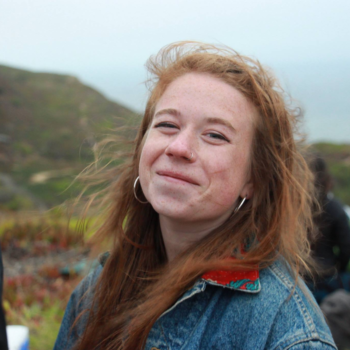We teamed up with Convergence Magazine to ask grassroots organizers from across the country what they learned during the 2022 elections. Here’s what Celina Culver from Showing Up for Racial Justice (SURJ) learned.
What’s an organizing success that you had during the midterms that gives you hope?
As a part of a coalition of statewide organizations with Protect Kentucky Access, Showing Up for Racial Justice (SURJ) made over 110,000 calls into the state to turn out voters — in our case, specifically voters in majority-white areas — to vote “no” on Amendment 2, which would have created a constitutional ban on abortion in the state. Our national membership team led phonebanks with SURJ members from around the country who could make calls and send texts to support this work. I organize on the ground in Ashland, Kentucky — a small town in the Eastern Appalachian part of the state — as a part of the Kentucky People’s Union, a project of SURJ. We brought our local, on-the-ground folks into leadership on the phonebanks as well as in-person voter outreach. through local organizing.
Our members had deep conversations with Boyd County voters about the anti-abortion amendment, connecting with their neighbors and moving them to not only vote “no” but also to join KPU’s organizing efforts. This was a skill-up opportunity for our members, and the margin of support for the measure in Boyd County was much less than surrounding counties. This will make us stronger for our long-term organizing here in Eastern Kentucky — building power around issues like abortion that can deeply affect people’s lives and bringing people into long term organizing through direct voter contact.
What was the most effective message or tactic that the other side used? How did you try to combat it? Were you successful?
The anti-abortion, Pro-Amendment 2 side used the messaging they’ve long relied on — that people with so-called Christian or good moral values are anti-abortion. We combatted that by also using a values frame and messaging that opposing Amendment 2 is rooted in the value of solidarity. At SURJ, because we organize in majority-white communities, this message of solidarity is framed to help white people understand that their solidarity should lie with other working people of all races, and not white elites. Because the issue of abortion was chosen by the right to build power around a racist backlash to civil rights gains, we knew that to adequately get to the root of the abortion issue, we couldn’t ignore race, and we needed to name how this amendment was part of a wider strategy by extremist politicians to take away people’s rights.
All our campaign messaging is about being in solidarity with others, so in this campaign we said that even if you were not going to need an abortion because of your sex, your age, your personal decisions, or your gender, we need to be in solidarity with people who will need to decide to have an abortion for whatever reason. We tried to bring in that those who would suffer the most from this law are poor people, who are also disproportionately Black and brown people. Poor people would have to drive many hours, maybe lose their jobs, if they couldn’t access abortion in the state. We asked,”How can we see ourselves in those people and remember times we have had to struggle, others have had to struggle? Why are we trying to take it away from others or to make life harder for others?”
What did you think was going to work that didn’t work?
I thought the awareness of everyday people would be higher because we did so much calling, knocking, and social media outreach. But then I realized it hadn’t gone as far as I thought. On Election Day, I was standing outside Ashland Community College talking to people about why they should vote, and so many people were still saying, “Oh, I didn’t know abortion was on the ballot.”
What did you learn through the midterms that we can use in the next phase of the fight against the MAGA right?
Our people — working-class white people in the South — are ready. People are looking for opportunities to take action on their values. It’s our role as organizers to give them opportunities to take action, and elections are a huge way to do that, especially on issues that are near and dear to people’s livelihoods and lives. We had doubts about going all in to block this amendment, but connecting with people about material conditions and the things that are actually going on in their lives is how we bring people in. Amendment 2 was no different. We won on abortion in a red state with Rand Paul and Mitch McConnell as our senators. When we make assumptions and choose things for our members, that’s a mistake.
Additionally, this win speaks to the ways that a national organization can help move the needle on local or statewide work that not only wins campaigns, but also strengthens both local and national organizing infrastructure. We had working-class Kentuckians leading phonebanks, welcoming SURJ volunteers from across the country into the campaign. After the election, we hosted a statewide Kentucky call where over 600 people we identified from phone banking or texting signed up to join the local SURJ and KPU chapters. We had over 800 volunteers as part of our midterm work this cycle. As we’re all looking to power up our work for the 2024 election, engaging around this issue was a way that we developed leaders and built infrastructure across the organization.
Read more in our View from the Grassroots series:
- Brendan Walsh, Worker Power (Arizona)
- Elianne Farhat, TakeAction MN (Minnesota)
- Daniel Altschuler, Maegan Llerena, and Leo Murrieta, Make the Road Action (New York, Pennsylvania, Nevada)
- Tascha van Auken & Divya Sundaram, NY Working Families Party (New York)
- Carrie Santoro, PA Stands Up (Pennsylvania)
- Sam Smith, PA United (Pennsylvania)
- Jay Malone, Texas Gulf Coast Area Labor Federation (Texas)
- Katey Lauer, West Virginia Can’t Wait (West Virginia)
- Christine Neumann-Ortiz, Voces de la Frontera Action (Wisconsin)
- Grecia Lim, Community Change

